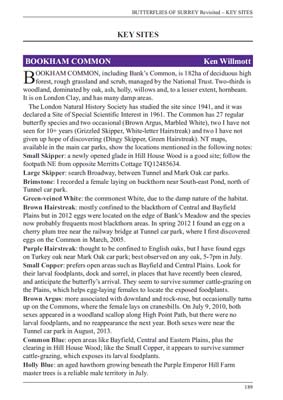Editorial team: Ken Willmott, Malcolm Bridge, Harry E. Clarke and Francis Kelly
Published by the Surrey Wildlife Trust, October 2013
Hardback, 240 pages. ISBN: 978-0-9556188-4-0
From the publisher: Butterflies of Surrey Revisited, published in October 2013, is the 14th book in the Surrey Wildlife Atlas series and the first to be full colour. It is neither a revision nor second edition of 1995's Butterflies of Surrey. With 240 pages and 110 photographs, it is a new work by members of Butterfly Conservation Surrey branch that takes advantage of additional data and improved technology. Butterflies of Surrey Revisited, with legendary lepidopterist Ken Willmott as chief author, sheds new light on many of the county's 42 regular species. It is a mine of information that will delight natural history lovers in Surrey and beyond.
The first thing to notice about this book is the stunning photo of a Purple Emperor taken by the book's chief author, Ken Willmott. It really is quite striking! I'm pleased to say that, in this instance, you can judge a book by its cover as this review will explain. (Please note that you can click on each image on this page to see a larger version).
 |
First off, don't be fooled by the title. While this book is number 14 in the Surrey Wildlife Atlas series, superseding number 1 (Butterflies of Surrey by Graham Collins, 1995), this is a new book that is "neither a revision nor a second edition". A lot can, and has, happened in the last 18 years.
Secondly, don't think for a minute that, because this book is about the butterflies of Surrey, there's nothing in it for you if you don't live in the county. Having spent some time in the company of Ken Willmott during the Big Butterfly Race, it was easy to see (following a discussion on the egg-laying habits of the Wall butterfly, as it happens) why Ken is considered to be one of Britain's top butterfly experts; what Ken doesn't know about butterflies probably isn't worth knowing. And I'm pleased to say that the field experience of Ken and the other writers has overflowed onto the pages of this fine book in much the same style as the ground-breaking The Butterflies of Great Britain and Ireland by Jeremy Thomas and Richard Lewington. I have to admit, this approach really won me over. What could have been a pretty dry read has been turned into a work full of experience and anecdotes. I hope future authors take note!
In terms of detail, the book is 240 pages long and produced to a high quality, with colour pictures throughout. The species and site descriptions are complemented with a vast array of material, including topics such as geology, ecology, weather, gardening and photography. The list of appendices is also extensive, with information on flight times, larval foodplants, nectar sources and the like. All of this material is brought together into a logical sequence that would allow you, should you so wish, to read this book from cover to cover without needing to skip between sections.
 |  |
The "meat" of the book is reserved, unsurprisingly, for the species accounts and site descriptions, where this book excels. Each species account has a distribution map, abundance map, flight time chart, and extensive transect information that shows how the fortunes of each species has faired. These are complemented with details of identification tips, wingspan, confusion species, key sites, lifecycle and, of course, a species writeup where the experience and anecdotes mentioned earlier shine through.
 |  |
 |  |
I was also impressed that the book contains a detailed description of a well-known introduction of Glanville Fritillary at Wrecclesham. In addition to the resident species, there are also summaries of rare migrants and extinctions, some of which (Duke of Burgundy, Small Pearl-bordered Fritillary, Pearl-bordered Fritillary) have become extinct in the county since the 1990s.
Having visited several sites mentioned in the key sites section myself, it was pleasing to read a description of the history of each site, the management performed at each site, the species found there and the main areas to search. I know I'll be putting this information to good use when I next visit Surrey.
 |  |
The only minor criticism is that the book does treat some subjects half-heartedly. The section on day-flying moths, for example, mentions 23 species spread across a mere 2 pages, and is undoubtedly failing to do justice to the topic. The section on photography, at 3 pages, is similarly brief. I can only assume that these sections are included to make for a more-rounded book for the general enthusiast and, in fairness, these sections do make reference to further reading.
All in all, this is a wonderful work and the writers, editorial team and production team are to be congratulated for bringing such a beautiful work to fruition and, as such, this book is highly recommended.
For those reading this review in time, the book will be formally announced on October 12th at the 2013 Amateur Entomologists Society (AES) Exhibition at Kempton Park where, I'm sure, some of the editors and writers will be in attendance where you can get your questions answered and book autographed. I'll certainly be taking my review copy along.
The book costs £16 + £2.75 p&p and can be purchased from the Surrey Wildlife Trust Web shop.